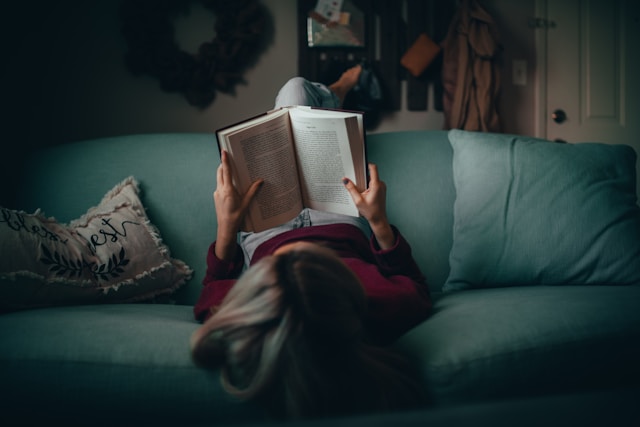There’s something magical about having a dedicated space where you can lose yourself in a good book or even just focus on a challenging puzzle. A book nook is a sanctuary where you can better enjoy these types of screen-free activities that help with relaxation and mental stimulation.
Why Create a Dedicated Book Space?
Everything is becoming more digital, and we’re constantly looking at TV screens, phone screens, tablets, watches, and the list goes on. Sometimes you just need a break from everything. Book nooks are like blanket forts for adults. They are a safe space that bring you immediate joy just thinking about them. Knowing that you have this relaxing area waiting at home after a long day at work is something that you’ll be looking forward to each and every day.
Books require focus, and can also reduce stress. By creating a dedicated nook for these activities, you’re establishing a ritual space that signals to your brain it’s time to slow down and engage in mindful recreation.
Choosing the Perfect Location

The best book nook should be in a quiet, comfy, and well-lit area. Here are some of the best options:
Living Room Corner: An unused corner can be transformed with a comfortable chair and small side table, or even a big floor cushion. This works well if you enjoy being part of the household flow while still having your own space, or if you need to keep an eye on kids.
Bedroom Reading Nook: Position a chair near a window or create a cozy corner with floor cushions. This location offers privacy and can be a calming pre-sleep ritual space. I’ve had the best sleep ever after spending an hour or two reading in my nook before bed.
Home Office Multipurpose Area: If you have a home office, you could designate a small area for your nook. You already know it’s a quiet area – why not expand it into a comfy after-work reading nook.
Under-Stair Nook: If you have space under a staircase, this can become a uniquely cozy hideaway with some creative decoration. Become Harry Potter by fixing up that under-stairs area. It doesn’t have to be grim if you put in a lamp, cushions and blankets.
Spare Room or Guest Room: A less-used room can make for a more elaborate setup with dedicated storage for your books and more space to spread out in. If your spare room is always empty or being used for a hobby that you’ve lost interest, it doesn’t take much to make it into a comfy book nook.
Essential Furniture and Setup

Seating: Use a chair that’ll be comfy for long periods. You’ll most likely spend more hours that you think in your little nook. Personally, I use a sleeper couch with the backrest angled at 45 degrees and a huge cushion.
Work Surface: If you’re using your nook for puzzles or puzzle books – you’ll need a flat surface at the right height. A small table, TV tray, or even a lap desk can work. Some people prefer puzzle boards or mats that can be stored away when not in use.
Storage Solutions: Install floating shelves for books, or use a small bookcase. For puzzles, consider drawers or boxes to organize pieces, and shelving to store completed puzzles or puzzle boxes.
Lighting: Good lighting is needed for every activity. Natural light is ideal during the day, but you’ll also need task lighting. A floor lamp with an adjustable arm or a table lamp that can be directed where needed works well. I always use a smart bulb in my lamp, so I can adjust the brightness and color from my phone. I also have schedules set so that the light will become softer closer to bedtime.
Creating the Right Atmosphere
Color Scheme: Choose calming colors that promote concentration. Soft blues, warm grays, sage greens, or neutral earth tones can help to create a serene environment. Avoid overly stimulating colors that might distract from your activities. This doesn’t mean a full repaint. Simply use blankets or mats with relaxing colors.
Comfort Elements: Add soft textures with your cushions and throws, or add a small area rug. These can make the space feel separate from the rest of your home and send a signal to your brain that this is a place for relaxation.
Personal Touches: Include items that inspire you – like a small plant, artwork, or any type of meaningful object. But keep your decorations minimal to avoid clutter that could distract from your focus.
Sound Management: How bad does noise affect your concentration? You might want to position your nook away from busy areas in your home or add soft furnishings that help absorb sound.
Organizing Your Materials
Book Organization: Keep your nook tidy at all times. Keep a small selection of current reads easily accessible, but store the rest nearby. This’ll prevent your books piling up when you suddenly decide to switch books. Have a small mix of genres available to match your mood. Having too many books out can also lead to you not being able to make on-the-spot decision on what to read – especially if you have ADHD. Also, keep lots of bookmarks on-hand.
Puzzle Storage: Store puzzles by piece count or difficulty level. Keep works-in-progress on your work surface or on a dedicated puzzle mat that can be rolled up. Have a system for sorting pieces – small bowls or a divided tray work well.
Tools and Accessories: Keep reading glasses, bookmarks, puzzle sorters, and other accessories within easy reach. It’s not really a nook if you have to get up every few minutes to fetch something from another room. A small side table or wall-mounted organizer can hold these items – though a shoebox will work just as well.
Maximizing Small Spaces
Even in small homes, you can create an effective book nook with creative solutions:
Vertical Storage: Use wall-mounted shelves and organizers to maximize storage without taking up floor space. There are some great shelves that can fit in a small corner that are designed just for books.
Multi-Functional Furniture: An ottoman with storage can hold puzzles and provide extra seating. A small table with drawers serves dual purposes. I use a ottoman for storage – as it makes a great footrest.
Portable Setup: Create a “nook kit” in a basket or box that can be moved to different locations as needed. Include a lap desk, reading materials, current puzzle and a blanket.
Fold-Away Options: Consider furniture that can be folded or nested when not in use, such as a folding table or stacking stools.
Maintaining Your Nook
Keep your book nook organized and inviting by sticking to simple maintenance routines:
Daily Tidying: Spend a few seconds each day putting materials back in their chosen places. Trust me – your place loses its allure when it gets untidy. Make it a routine to take an extra 30 seconds to put things in place before leaving your nook.
Weekly Refresh: Take time weekly to evaluate your book selection, rotate puzzle options, and dust surfaces. This prevents the space from becoming stale.
Seasonal Updates: Change out comfort items like throws or cushions seasonally to keep the space feeling fresh and inspiring.
Digital Boundaries: Keep electronic devices out of this space to maintain its purpose as a screen-free zone. You can put your phone on Do Not Disturb and adjust settings so that you are still contactable in emergencies.
Making It Work for Your Lifestyle
Consider how you’ll realistically use this space and plan accordingly:
Time of Day: Think about when you’re most likely to use the nook and ensure lighting and comfort are optimized for those times. If your window gets direct sunlight, you could be getting sunburnt during your long reading session.
Activity Duration: If you prefer short reading sessions, prioritize comfort and easy access. For long puzzle sessions, focus on ergonomics and organization. You don’t want your enjoyable puzzle session to lead to a visit to a chiropractor.
Seasonal Considerations: In colder months, you might want to ensure the space is cozy and warm. In summer, good ventilation and lighting that doesn’t add heat become important. I keep a little clip fan next to me all year long. On hot days, I can keep cool, but even on cooler days, I sometimes feel like having some cool air on my face.
Family Considerations: If others in your household might use the space, design it to accommodate different preferences and heights, ie. stop your kids and pets from destroying your books.
Final Thoughts
In order to create the perfect book nook, you’ll need to sit and think about all the things that comfort you most, and then find a way to fit them into your space. You want this area to feel separate to your everyday life – a place that will bring you instant comfort as soon as you sit down.
Start with the basics: comfortable seating, good lighting, and organization systems that work for your lifestyle. From there, you can slowly add other items that will make the space uniquely yours. Remember that the perfect nook is one that you’ll actually use, so prioritize functionality and comfort over elaborate, and expensive, design.
You want a space where you can disconnect from the busy world and reconnect with the simple pleasure of focused and mindful activity.




